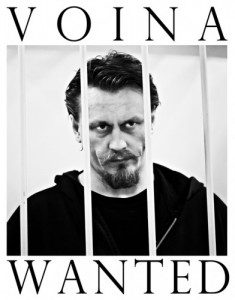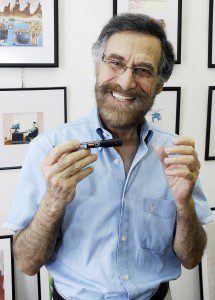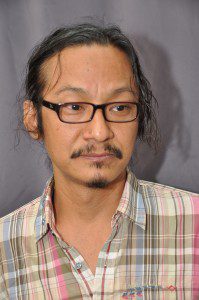15 Mar 2012 | Russia
Moscow city court has refused to release two members of punk feminist group Pussy Riot. Nadezhda Tolokonnikova and Maria Alekhina were arrested after having performed a protest song “Mother of God, send Putin away” in Moscow’s Christ the Saviour cathedral on charge of hooliganism. Now they will be staying under arrest until 24 April, when they face trial and might be sentenced to up to seven years in prison.
The case is seen as politically motivated as Russia’s prime minister Vladimir Putin, who has just won the presidential elections, was likely to take offence at the protest, according to Tolokonnikova’s husband and Moscow art activist Petr Verzilov. That might be the reason why the court did not take into consideration that both Tolokonnikova and Alekhina have young children.
Lawyers for members of Pussy Riot have expressed concern that the judge who sanctioned their arrest is also offended and biased: in July 2010 she tried a case against organisers of the “Forbidden Art” exhibition. They were found guilty of “debasing religious beliefs of citizens and inciting religious hatred”. Tolokonnikova together with other Voina activists protested against the verdict by bringing cockroaches to the court room and letting them free there.
Russia’s leading human rights activists Lyudmila Alekseeva and Lev Ponomaryov have condemned Tolokonnikova’s and Alekhina’s arrest, calling the court decision “repressive” and highlighting selectivity of Russian judicial system.
While Pussy Riot remains under arrest awaiting trial, a policeman in the city of Kazan who is suspected of violence against a detainee which led to his death was released before the trial. The policeman together with his colleagues in Kazan’s Dalni police department allegedly raped the detainee with a champagne bottle.
A number of single pickets supporting Tolokonnikova’s and Alekhina’s have taken place near the court building. Three protesters were arrested for breaking the rules on pickets after instigators, allegedly from pro-Kremlin youth movements, tried to attack them, take away their placards and initiate a scuffle. Activists in Novosibirsk have created “icons” depicting Pussy Riot members. The church has already called it hooliganism and asked for an investigation.
Meanwhile another political prisoner, Taisiya Osipova — a member of The Other Russia opposition movement, and also a mother of a small child — has been refused freedom until her trial in Smolensk. She was sentenced to ten years on charges of drug trafficking in December. After mass protests against her prosecution, with even President Medvedev saying the verdict was “too cruel”, the court cancelled the verdict and submitted the case for reconsideration. Osipova, who has diabetes and claims the case was trumped-up as a revenge for her and her husband’s membership in The Other Russia, was to be released on 13 March. Now she will stay under arrest until 15 June. Her supporters also worry that the biased court will find her guilty again.
Both Osipova and Pussy Riot’s cases were subjects of mass protest rallies in Moscow. All the rallies’ resolutions included the demand to release political prisoners immediately. Just as the other requirements, this one was not fulfilled by Russian authorities.
If anyone doubted that protest mood remained strong in Russia, politically motivated cases might be the reason not to have any more doubts.
7 Mar 2012 | Africa, Sub-Saharan Africa
 “Slum is a tricky word. It conjures up images out of control. The threatening. The miserable. The lawless,” thus wrote Richard Swift in his article “Welcome to Squatter Town” for The New Internationalist. This publicity raised awareness of the difficulties of slum living in Kenya, but it also highlighted the negative aspects of life in these settlements. 60 per cent of people in Nairobi live in slums or informal settlements. You can’t romanticise it. There is hunger, poverty, dire sanitation and overcrowding, with around 200,000 people living in an area approximately 630 acres (similar to 630 football pitches).
“Slum is a tricky word. It conjures up images out of control. The threatening. The miserable. The lawless,” thus wrote Richard Swift in his article “Welcome to Squatter Town” for The New Internationalist. This publicity raised awareness of the difficulties of slum living in Kenya, but it also highlighted the negative aspects of life in these settlements. 60 per cent of people in Nairobi live in slums or informal settlements. You can’t romanticise it. There is hunger, poverty, dire sanitation and overcrowding, with around 200,000 people living in an area approximately 630 acres (similar to 630 football pitches).
But, if you look for them, there are also high expectations, enterprise and thriving creative expression.
In a small room crammed with paintings and metal sculptures partially illuminated by sunlight concentrated through two small windows, eight artists form a collective know as Maasai Mbili in one of Africa’s largest informal settlements, Kibera. The group started in 2001 when friends Otieno Gomba and Otieno Kota decided to combine forces to create a studio space. In 2003 they purchased their current building, turning what had previously been a dodgy bar into a centre of artistic expression and tolerance.
Most of the artists now affiliated with the studio started as sign writers, and in a style directly influenced from this past they create works of visual texts. It makes for hilarious and perceptive art. Otieno Gomba’s piece Save Our Souls features the tread of a running shoe and alludes to both the culture of recycling in Kibera and the depravity found there, while Ashif Malamba’s Somali Pirate series pokes fun at the media’s recent fixation with banditry on East Africa’s coastline.
Using the street as their primary inspiration, Gomba says, “It couldn’t be art if it was just eight artists locked in a room.” Their studio doors bear the word “karibu”, welcome, an open invitation to the community. The work here is not a reflection of life in Kibera, but a representation of it. From the canvases that are primed with a mixture of paint and rubble to mimic the walls of houses, to snippets of conversation overheard in bars that feature in Kevo’s paintings, this is art that is intrinsically bound up with the community in a relationship approaching symbiosis.
 As well as creating a neutral space where people can come to them, Maasai Mbili also undertake outreach programmes. Mbuthia Maina holds informal art classes for children where they can “paint what they want” and “pour out their minds”. In a country where art has been sidelined in the national curriculum, this opportunity to explore creativity in an unmediated environment carries even more importance. Not only to does it contribute to building imaginative capacity, but crucially it also provides children with a vehicle to express the issues they see around them but are powerless to control.
As well as creating a neutral space where people can come to them, Maasai Mbili also undertake outreach programmes. Mbuthia Maina holds informal art classes for children where they can “paint what they want” and “pour out their minds”. In a country where art has been sidelined in the national curriculum, this opportunity to explore creativity in an unmediated environment carries even more importance. Not only to does it contribute to building imaginative capacity, but crucially it also provides children with a vehicle to express the issues they see around them but are powerless to control.
Maasai Mbili have created a network of influence within their community, and in the process are building consensus around the idea that there are other possibilities and futures to explore. “Mental attitudes are changing,” said Gomba, speaking of the youth who once saw their options as limited. Rather than turning to a life of petty crime, they now see art as a viable means of making a living. It is a message which is no doubt made all the more powerful because it comes from those who have grown through the same circumstances they have.
The initiative that Maasai Mbili are best known for arose out of the post-election violence of December 2007. Almost overnight, neighbours turned on each other for being from the “wrong tribe”. The death toll rose almost daily for weeks. Amidst the chaos, members of Maasai Mbili decided to use the paintbrush as their main tool in an effort to restore social cohesion. Using street art as a form of visual resistance to unfolding events, they painted Kibera’s ruins, adding colour to blackened buildings and daubing walls with the words “PEACE WANTED ALIVE”. At the time Gomba asked himself, “What is the impact of art in the community? What is the role of art in the time?” In short, how does art influence interaction with our environment, and by extension, our behaviour in it? Art For Peace was born.
Identifying children as having suffered the brunt of the trauma, Art For Peace then embarked on a series of programmes that encouraged youth to address the violence that had engulfed them through creative means. It was “a form of therapy” Gomba said, and an initiative that drew considerable media attention. In the months that followed camera crews and dignitaries flocked to see how a group of dreadlocked artists had begun to address the horrors that those most vulnerable in their community had born witness to.
 Now that the violence is over the world’s gaze has moved elsewhere, but for Maasai Mbili the work goes on as they continue to engineer positive social change through art. As Gomba aptly put it, “Art For Peace is eternal. It has no limit. It doesn’t just apply to Kenya. It has no boundaries.”
Now that the violence is over the world’s gaze has moved elsewhere, but for Maasai Mbili the work goes on as they continue to engineer positive social change through art. As Gomba aptly put it, “Art For Peace is eternal. It has no limit. It doesn’t just apply to Kenya. It has no boundaries.”
Maasai Mbili utilise art to effect lasting social change, and they have another pressing goal: to see street art recognised as a legitimate art form. “Street art is sidelined,” said Ashif, “although now there is some recognition. We want to integrate street art with gallery art.” With limited gallery space across Nairobi, compounded by high costs associated with exhibiting, this is ongoing struggle. However when they do get the chance to exhibit, their work consistently sells out. “Our perspective is unique,” Says Ashif, “it is a commentary that is social, personal, economic and political. And it is also full of humour.” Maasai Mbili opens up alternative paths of understanding and gives fleeting access into the visual culture and identity of their community in Kibera.
African Street Art deserves a place in global contemporary discourse. It has meaning beyond commoditisation and market whims. Street Art directly engages with communities through its own language. It changes behaviour and opens up new possibilities; it holds the potential to shape our society. Art — from the street to the gallery — forms an integral part of our national identity.
Musimbi King is a freelance journalist in Nairobi focusing on creative industry in Africa and the role this sector can play in promoting socio-economic growth across the continent.
29 Feb 2012 | Awards
Recognising artists, filmmakers and writers whose work asserts artistic freedom and battles against repression and injustice
Voina, performance artists, Russia
 Voina, meaning “War”, is a collective of radical Russian anarchist artists who combine political protest and performance art.
Voina, meaning “War”, is a collective of radical Russian anarchist artists who combine political protest and performance art.
Voina’s carries out actions directed against the authorities. In June 2010, members painted a 65-metre phallus on a drawbridge in St Petersburg which, when raised, faced the city headquarters of the federal security service.
Voina members Vorotnikov and Leonid Nikolayev were imprisoned from November 2010 to February 2011 in connection with an anti-corruption protest and, in July 2011, Russian police issued an international arrest warrant for Vorotnikov. A warrant for the arrest of fellow artist Natalia Sokol was issued in December 2011.
Ai Weiwei, artist, China
 AiWeiwei is a Chinese artist and activist whose work incorporates social and political activism. He has investigated corruption and cover-ups and openly criticised the Chinese government’s record on human rights.
AiWeiwei is a Chinese artist and activist whose work incorporates social and political activism. He has investigated corruption and cover-ups and openly criticised the Chinese government’s record on human rights.
Ai’s 81-day detention in 2011 caused international uproar. He was arrested in April, alongside several of his friends and colleagues. Since the Chinese authorities released him on bail in June 2011, he has been fined $2.4 million in back taxes and penalties. Though officials arrested Ai for alleged economic crimes, supporters say he was punished for his activism and vocal critiques of the government. He paid a $1.3 million bond with loans from supporters, who contributed online and in person and even throwing cash over the walls of his studio in Beijing.
In November 2011, after Ai announced that authorities were investigating his cameraman for pornography in connection with photos that featured the artist and four women naked, internet users responded tweeting nude photos of themselves in support.
Ali Ferzat, cartoonist, Syria
 Syrian cartoonist Ali Ferzat has been called “an icon of freedom in the Arab world”. He has spent decades ridiculing dictators in more than 15,000 caricatures. His depictions of President Assad and the police state have helped galvanise revolt in Syria.
Syrian cartoonist Ali Ferzat has been called “an icon of freedom in the Arab world”. He has spent decades ridiculing dictators in more than 15,000 caricatures. His depictions of President Assad and the police state have helped galvanise revolt in Syria.
In August 2011, Ferzat was wrenched from his vehicle in central Damascus by pro-Assad masked gunmen who beat him badly and broke his hands. Passers-by found Ferzat dumped at the side of a road; his briefcase and the drawings inside it had been confiscated by his attackers.
Ferzat earned regional and international recognition in the 1980s with stinging cartoons of officials, autocrats and dictators including Saddam Hussein and Muammar Gaddafi. Saddam Hussein called for Ferzat’s death in 1989 after an unfavourable portrait of him was exhibited in Paris and Ferzat’s cartoons have been banned in numerous Arabic countries.
Min Htin Ko Ko Gyi, poet, Burma
 Min Htin Ko Ko Gyi, a poet, filmmaker and screenwriter, co-founded Burma’s inaugural Arts of Freedom Film Festival, which took place in early January 2012.
Min Htin Ko Ko Gyi, a poet, filmmaker and screenwriter, co-founded Burma’s inaugural Arts of Freedom Film Festival, which took place in early January 2012.
Burmese citizens were invited to create a short film on the theme of freedom. Despite the state media’s refusal to cover the announcement, Ko Ko Gyi and his organisers received 188 submissions. Thousands gathered in Rangoon under the banner “Free Art, free thought, freedom”, to watch the selected films. More than 7,000 attendees voted for Cut This Scene to win one of five awards. The film is a satire of a government censorship committee struggling to set the criteria by which to censor films.

18 Jan 2012 | Asia and Pacific, News and features
 As religious leaders call to ban Salman Rushdie from the Jaipur festival in India, Salil Tripathi reports on the country’s “sepulchral silence”
As religious leaders call to ban Salman Rushdie from the Jaipur festival in India, Salil Tripathi reports on the country’s “sepulchral silence”
** Update 20 January 2012 ** – Salman Rushdie tweeted this morning:
Read more here
(more…)









